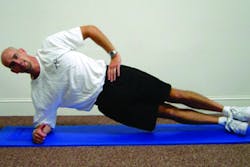Injuries are a part of law enforcement, an accepted fact of the job. Most injuries occur from predictable event such as arresting a subject or a foot pursuit. But many injuries occur from simply walking or training activities. 24% of all injuries are deemed “overexertion” injuries where the tissue fails under stress or load. With the average cost of an injury around $5k and lower back injuries around $14k we have a problem. If an officer is forced to be out of work for over 90 days data shows that there is less than a 20% chance that they will ever return to the street.
One of the most important things that we can do to stay injury free is to choose exercises that will not hurt us. While this seems simple in concept I see officers every day that are doing exercise that will hurt them. Am I happy that they are in the gym? absolutely but there is a better way. In previous articles I talked about postural distortions and biomechanical patterns that lead to tissue failure and injury, I strongly encourage you to reference those articles.
Whether your department tests you physically or not you have an obligation as an officer to be able to perform the tasks of your job while keeping yourself safe and injury free. Fitness and wellness is a necessity not an option, have pride in the uniform your wear and the skills that you possess but that also involves looking the part too. Since there are so many myths surrounding exercise and injury prevention let’s look at fitness myths first.
First let’s delve into some of the many myths and misconceptions surrounding exercise. There are many officers that try hard to stay fit and healthy in our high stress job. Sadly some of the common exercises used to prevent injury do just the opposite, they actually encourage it. Take the back extension, commonly thought to “strengthen the back” this exercise actually loads over 890 lb of compression on the spine. As officers you sit a lot, to complicate that you lean forward a lot. Sitting and leaning forward for long periods causes constant load on the spinal disks and fatigues the back extensor musculature, to further load this tissue with a dangerous exercise and do repetitions, sometimes with weight makes no sense, there is a better way.
The abdominal crunch is what we all think of when it comes to exercising the abdominal wall, leg raises are usually a close second. Again what we know we may know wrong. The National Institute for Occupational Safety and Health (NIOSH) has set the action limit for lower back compression at 3300N or 730lbs of compression on the disks. Repetitive loading above this has been clearly linked to higher injury rates, but this 730lb compressive load is imposed on the spine each repetition of the sit up, no matter what variation you try! There is a better way.
Data clearly shows that prolonged trunk flexion especially with twisting and while seated vastly increases injury chances. Frequent lifting, pulling and pushing and poor torso muscle endurance have also been shown in numerous studies to increase injury risk. So with all the inherent risks in our job what is a law enforcement professional to do?
1) Use corrective exercises to counteract the effects of your job. A corrective exercise simply works to “fix” the imbalances that our job causes. Hip flexor stretching to decompress the pelvis reduces load on the disks. Simple exercises like over head cable pulls, bird dogs and lateral planks are safe and extremely effective exercises to not only prevent injury but help you get fit, and no machines needed.
2) Practice the “S-M-F” principle. Simply stated the SMF principle, which this author coined, are the 3 keys to preventing injury while improving fitness. S stands for Stability. Stability of the torso means you have the ability to rapidly “brace” the abdominal wall and “stiffen” the spine when performing any task. From picking up the monitor to an obese patient on the cot if you can brace on command your back has over a 42% chance of not being injured. M stands for Mobility of your tissue. Poor posture, injury, repetitive motion trauma and sports, to name a few, cause adhesions to form in the muscles. Commonly called trigger points these little knots of scar tissue change how a muscle fires which changes the overall firing pattern of the muscle group. While you cannot stretch a trigger point we can mobilize it. A tennis ball is an EMT’s savior. Simply hold pressure over these painful spots to release the tissue and restore motion. As I teach in my injury prevention classes, healthy tissue does not hurt to touch, unhealthy tissue does. Trigger point mobilization is self diagnostic; go find the spots that hurt until the sharpness lessens. This is a good way to pass the time while watching TV, who knew you could get a massage while on duty. F stands for Flexibility, in this case on duty stretching specifically designed to counteract the postural patterns inherent to public safety. Hip flexors, hamstrings, glutes, lats, chest and traps. These 6 stretches will help your body be able to handle the loads, lifts and movements needed to perform our job. All stretches need to be help for a full 60 seconds but the stretch should never be painful.
3) Healing foods. Tissue can also fail from chronic dehydration, poor diet, smoking and chronic stress hormones. Without writing a book on this topic there are some very simple ways to get healing foods into your body while on duty. As a society we consume far too many carbohydrates and protein and a pitiful amount of vegetables and fruits. Eat something green with every meal, darker veggies and leafy veggies are always a good choice. Substitute a carb. For a veggie any chance you get. Superfood drinks are a great way to sneak in some powerful nutrients while on duty. It always amazes me that when called to an altered medical status patient one of the primary thinks we do is start a line and give fluids, why? Because they are probably dehydrated, but so are you! Whole foods, water, and good meal choices will give your body the building blocks it needs to heal and deal with all those chronic stress hormones that are part of our job. I checked the Public Safety rule book and there is no law that states you must order a burger and fries. Make smart substitutions a grilled chicken sandwich and a salad, a turkey sub on whole wheat (no mayo or bacon), a smoothie for breakfast instead of an egg and bacon sandwich. There is a better way.
During your next shift ask yourself why you do things a certain way, why do you land with your knees locked as jumping a fence? why do you arrest a subject with your abdominal wall relaxed? Why do you always take the same knee in a shooters stance? All these patterns can lead to injury and many of the patterns are symptoms of a bigger problem within your body. There is a better way.
Web Links:
Bryan Fass is the author of “Fit Responder”, a comprehensive wellness plan for the first responder, and the Fit Responder Blog. Bryan has a Bachelor’s Degree in Sports Medicine and is certified as a licensed athletic trainer and a strength and conditioning specialist. He was a paramedic for over 8 years. Bryan has authored four books regarding fitness, wellness and human performance. Bryan is available for Consulting and Speaking on Public Safety Fitness Testing along with Fitness, Wellness and Injury Prevention Programs. Contact him via email to [email protected].
About the Author
Bryan Fass
is a leading expert on public safety injury prevention. As the president and founder of Fit Responder Bryan’s company works nationally with departments, corporations; state and local governments to design and run targeted injury prevention and wellness programs. He is frequently contacted for expert opinion and content contribution for all aspects of public safety fitness, ergonomics and wellness. Bryan authored the Fit Responder book used by departments and schools plus writes for numerous web and peer-reviewed journals including the NSCA-Tactical Strength & Conditioning journal, officer.com, ems-1.com & best practices in EMS. Bryan holds a bachelors’ degree in sports medicine with over 17 years of clinical practice, was a paramedic for over 8 years, and is certified as an Athletic Trainer (ATC, LAT), Strength Coach (CSCS) and the Functional Movement Screen (FMS). Fit Responder developed the nation’s first validated pre-hire Physical Abilities Test for EMS. Bryan is a sought-after speaker on a variety of topics including risk reduction, employee self-care, real world wellness and How to Eat on the street. www.fitresponder.com
Every Lift Counts!

